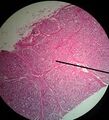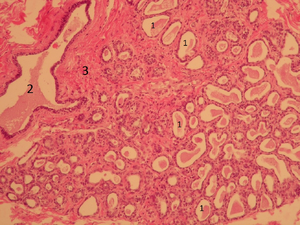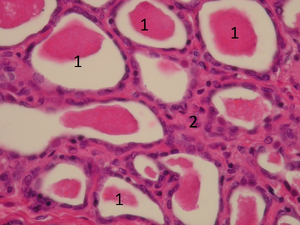Mamma lactans (SFLT)
Mammary gland[edit | edit source]
Clear magnification. The mammary gland is an apocrine, tuboalveolar gland. Typical for it are very wide ducts located in the interlobular ligament.
Mammary gland (hematoxylin-eosin staining)[edit | edit source]
The secretory part of the mammary gland. This is a tuboalveolar gland, because the tubules of the secretory compartments have a clearly visible lumen. Milk protein is secreted from the secretory cells by secretory granules (merocrinally), whereas fat enters the milk by apocytosis (by cleavage of a fat droplet together with part of the cytoplasm). The functional state of the mammary gland is controlled hormonally; in addition to estrogens, progesterone and placental hormones, prolactin and oxytocin are involved in the control of lactation.
Mammary gland, mamma lactans (hematoxylin-eosin staining)[edit | edit source]
The dilated secretory compartments are filled with milk. The specimen shows a very wide interlobular duct. The growth of the secretory compartment of the mammary gland is stimulated by hormones during pregnancy. Oxytocin and prolactin stimulate milk production after birth.
1 - secretory compartments (alveoli) 2 - interlobular duct 3 - interlobular septum - denser collagenous connective tissue
Mammary gland, mamma lactans (haematoxylin-eosin staining)[edit | edit source]
Secretory compartments of the tuboalveolar gland.
1 - dilated secretory compartments filled with milk 2 - connective stroma of the gland








